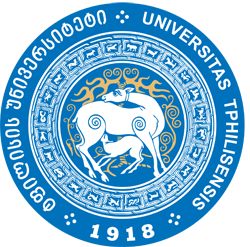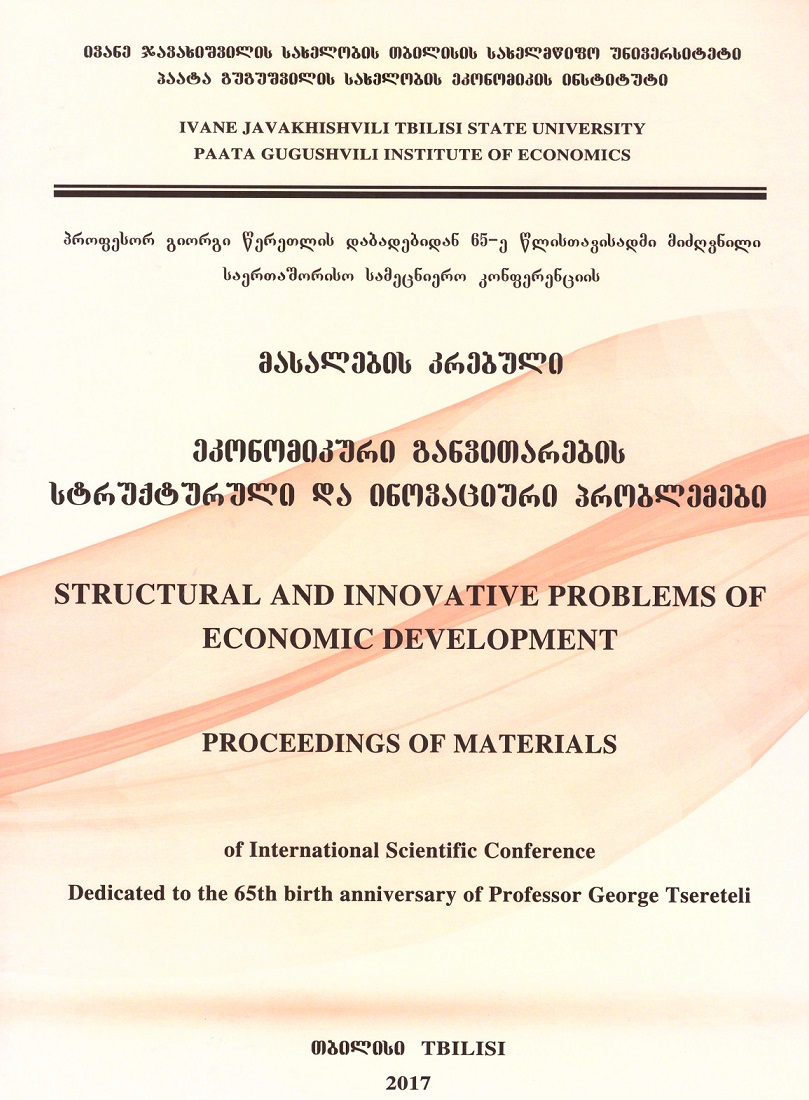
Ivane Javakhishvili Tbilisi State University
Paata Gugushvili Institute of Economics International Scientific

INFORMATION ASYMMETRY AND INNOVATION FINANCING IN GEORGIA
Annotation. This article examines the systemic problem of innovation financing in Georgia through the prism of Joseph Stiglitz's theory of information asymmetry. Special attention is paid to the analysis of the reasons for the market failure in the segment of venture investments and startup lending. The necessity of active state participation for the formation of a sustainable ecosystem of support for technological entrepreneurship is substantiated.
Keywords: innovation, startup financing, venture capital, information asymmetry, government participation, credit guarantees.
Introduction
The problem of chronic lack of financing in the early stages of innovative entrepreneurship in Georgia has long been the subject of discussion in the professional community. For a variety of startups and small innovative enterprises (MIPS) the so—called "valley of death" — the gap between creating a prototype and entering the market - turns out to be an almost insurmountable barrier due to the lack of available financial instruments.
A logical question arises: given the demand for investment, why is private capital in no hurry to occupy this niche? The answer is explained in the theory of information asymmetry, developed in detail by Joseph Stiglitz. Stiglitz's theory of information asymmetry offers Georgia a systematic approach to solving key problems of innovative development through the creation of institutions that reduce information barriers. This is especially important in conditions of limited resources and the need for rapid growth of the innovation sector.
* * *
According to Stiglitz's theory of information asymmetry, the lack of reliable information between investors and entrepreneurs leads to chronic underfunding of innovation. For innovation, it creates:
• Adverse selection: banks cannot distinguish promising startups from risky ones. At the stage of considering an investment request, the investor does not have sufficient tools to reliably assess the quality of a startup. The lack of objective criteria and a reputation history leads to investors’ either significantly overestimating the cost of capital or completely refusing to participate in such transactions. In the long run, this displaces the most promising projects from the market, but those who do not want to put up with harsh conditions.
• Moral hazard: after receiving funding, entrepreneurs can change their behavior. After receiving financing, an entrepreneur is tempted to use resources for other purposes or reduce the level of engagement, knowing that the main financial losses will be incurred by the investor. Control over the expenditure of funds and project management requires significant transaction costs, which makes participation in innovative projects even less attractive for traditional capital market players.
• Credit rationing: even if companies are willing to pay high interest rates, they do not receive loans.
In Georgia, this is reflected in the extremely low level of investment in research and experimental development - only 0.32% of GDP as of 2024, which is significantly lower than the average level of EU countries (more than 2.35%). Forecasts for 2025 do not indicate a significant increase in this indicator. An additional barrier is the underdeveloped venture capital market. The total volume of venture capital transactions for 2024 is $25-30 million. When compared with international standards:
• Share of venture capital investments in Georgia's GDP: ~0.08% (2024)
• EU average: ~0.35% (2024)
• Gap with EU level: 4.4 times
It is predicted that by 2026, the market volume may reach $50-70 million due to the launch of new funds with government co-financing (for example, Fund of Funds), as well as the activity of corporate venture funds (CVC) and an increase in the number of successful exit deals that will attract new investors. Investments in high-tech sectors (IT, telecommunications) reached $120 million in 2023, with moderate growth projected for 2024 ($130-140 million). Despite the positive dynamics, these values are insufficient for a qualitative leap in the development of the innovation ecosystem. Thus, despite the positive dynamics, the Georgian venture capital market is still at the initial stage of development. As a result, the share of the IT sector in the country's GDP is ~4.5% (2024), while in the EU this figure reaches 8-10%, the volume of investments per capita in Georgia is $35-40 (2024), the EU average is $200-220 (2024).
All this points to the manifestation of asymmetry in the Georgian innovation sector and requires targeted efforts to stimulate the supply of capital and strengthen the investment infrastructure.
If we consider the banking sector, commercial banks in Georgia demonstrate a conservative approach to lending to innovative enterprises. The main requirement remains the provision of tangible collateral — real estate or liquid assets, which startups usually do not have. The field of intellectual property valuation is in its infancy, and the high transaction costs of analyzing atypical projects further reduce banks' interest in financing innovation. As a result, credit products for MIPS are either unavailable or offered on unfavorable terms.
As for venture capital, the development of the venture industry in the country is hampered by the lack of qualified management partners with experience in evaluating and supporting technology projects, so potential investors (limited partners) prefer traditional, more transparent and liquid assets. The classic problem of the "vicious circle" is that the lack of successful cases prevents the formation of trust, and the lack of trust prevents capital inflows.
Business angels and crowdfunding – these tools require a high level of public trust and a developed culture of collective investment. In practice, the low level of trust and limited experience of such interaction significantly limit the possibilities for attracting alternative sources of financing. It is worth noting that the problem of information asymmetry is aggravated by the lack of a well-developed system of institutional support and infrastructure for early examination of startup projects. Technology brokers, accelerators, and specialized government agencies do not yet have the necessary resources and expertise to reduce investment risks.
In international practice, government guarantees, the creation of mutual investment funds, as well as the development of educational and mentoring support programs for future managers and entrepreneurs are becoming effective tools for overcoming market failures. Angel investing and crowdfunding are, in fact, financial mechanisms, the existence of which critically depends on trust between the participants in the process. Without this trust, the very logic of such tools becomes fragile, if not completely impossible. A business angel, investing his own funds, counts not only on the prospects of the idea, but also on the honesty, competence and decency of the entrepreneur. In the case of crowdfunding, the situation is even more complicated: here we are talking about motivating anonymous people from a wide range to support the project, often based only on the description and charisma of the founders. In Georgian society, where the level of trust outside the family and a narrow circle of friends traditionally remains low, such tools face systemic limitations and develop extremely slowly.
Economic theory, in particular, the work of Joseph Stiglitz, quite clearly indicates that where the market is unable to independently build effective institutions or overcome the problems of asymmetric information, the state is obliged to intervene — not to displace the market, but to support and correct it. For Georgia, this thesis is of particular importance, given the historical and cultural characteristics of the country.
The first and perhaps the most important direction is the creation of public-private venture funds. This structure allows the state to act not just as a regulator or an outside observer, but as an active co-investor, taking on some of the risks along with private investors.
The second area is the development of a system of state guarantees on loans for innovative small and medium—sized enterprises. This measure makes banks more inclined to finance innovative projects, allowing them to retain the function of primary selection of borrowers, but minimizing potential losses. Similar schemes are successfully operating in many countries, stimulating lending to startups and technology companies even in conditions of low confidence.
The third area that needs attention is tax incentives for private investors. The introduction of tax credits or deductions for individuals and legal entities investing in certified startups or venture funds can significantly increase the attractiveness of high-risk investments. The lower the entry costs, the more likely it is that private capital will begin to actively seek new opportunities, even in conditions of uncertainty.
Fourth, infrastructure development: the government can invest in the creation of open and transparent crowdfunding platforms, as well as educational programs for potential investors. This not only reduces the cost of finding information and making deals, but also creates a new culture of trust in the market. Moreover, the state, acting as a guarantor of transparency, minimizes the risks of moral hazard and increases the overall security of the market.
Conclusion
The problem of financing innovation in Georgia is not just a matter of lack of capital, but a manifestation of deep—seated institutional constraints related to information asymmetry and low levels of social trust. Traditional financial institutions are not able to solve this complex of problems alone: to launch a full-fledged innovation ecosystem, active government involvement is necessary, especially in the early stages.
It is important to emphasize that the goal of this approach is not to create another "state feeder" for startups, but to create an ecosystem capable of operating independently after overcoming key institutional barriers. Government intervention should be temporary, but decisive, aimed at launching market mechanisms and building trust, without which an innovative economy is impossible.
The data show that solving the problems of information asymmetry can be a key factor in unlocking Georgia's innovation potential, especially in the context of European integration and the need to diversify the economy.
References:
- Stiglitz J.E., Weiss A. (1981) "Credit Rationing in Markets with Imperfect Information"
- National Bank of Georgia (2024) "SME Lending Report"
- The World Bank (2024) "Georgia: Financial Access and Inclusion"
- Agency for Innovation and Technology of Georgia (2024) "Startup Ecosystem Survey"
- OECD (2023) "Financing SMEs and Entrepreneurs: Georgia Profile"
- European Investment Bank (2024) "Barriers to Innovation Financing in the Southern Caucasus"
- Ministry of Economy of Georgia (2024) "Strategy for the development of innovative financing 2024-2027
